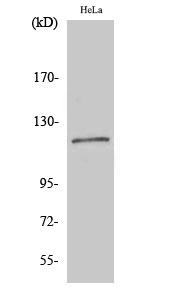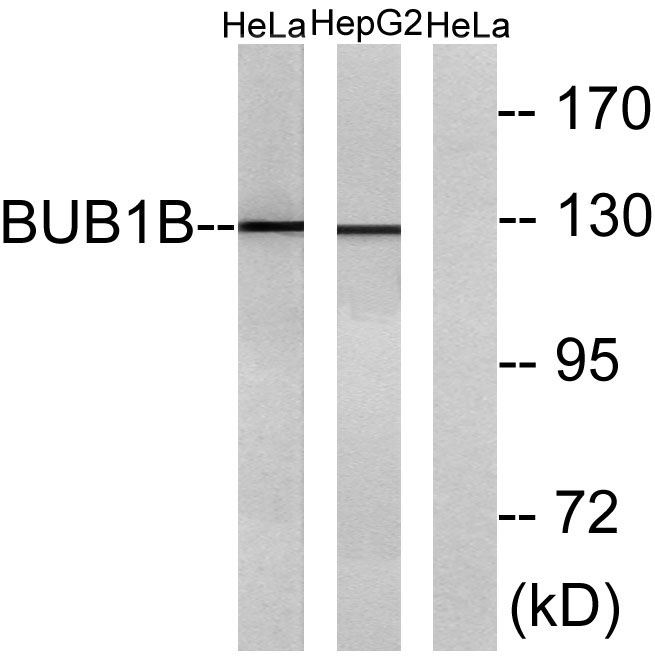BubR1 Polyclonal Antibody
- Catalog No.:YT0549
- Applications:WB;ELISA
- Reactivity:Human;Mouse
- Target:
- BubR1
- Fields:
- >>Cell cycle;>>Human T-cell leukemia virus 1 infection
- Gene Name:
- BUB1B
- Protein Name:
- Mitotic checkpoint serine/threonine-protein kinase BUB1 beta
- Human Gene Id:
- 701
- Human Swiss Prot No:
- O60566
- Mouse Gene Id:
- 12236
- Mouse Swiss Prot No:
- Q9Z1S0
- Immunogen:
- The antiserum was produced against synthesized peptide derived from human BUB1B. AA range:341-390
- Specificity:
- BubR1 Polyclonal Antibody detects endogenous levels of BubR1 protein.
- Formulation:
- Liquid in PBS containing 50% glycerol, 0.5% BSA and 0.02% sodium azide.
- Source:
- Polyclonal, Rabbit,IgG
- Dilution:
- WB 1:500 - 1:2000. ELISA: 1:20000. Not yet tested in other applications.
- Purification:
- The antibody was affinity-purified from rabbit antiserum by affinity-chromatography using epitope-specific immunogen.
- Concentration:
- 1 mg/ml
- Storage Stability:
- -15°C to -25°C/1 year(Do not lower than -25°C)
- Other Name:
- BUB1B;BUBR1;MAD3L;SSK1;Mitotic checkpoint serine/threonine-protein kinase BUB1 beta;MAD3/BUB1-related protein kinase;hBUBR1;Mitotic checkpoint kinase MAD3L;Protein SSK1
- Observed Band(KD):
- 130kD
- Background:
- This gene encodes a kinase involved in spindle checkpoint function. The protein has been localized to the kinetochore and plays a role in the inhibition of the anaphase-promoting complex/cyclosome (APC/C), delaying the onset of anaphase and ensuring proper chromosome segregation. Impaired spindle checkpoint function has been found in many forms of cancer. [provided by RefSeq, Jul 2008],
- Function:
- catalytic activity:ATP + a protein = ADP + a phosphoprotein.,disease:Defects in BUB1B are associated with tumor formation.,disease:Defects in BUB1B are the cause of mosaic variegated aneuploidy syndrome (MVA) [MIM:257300]. MVA is a severe autosomal recessive developmental disorder characterized by mosaic aneuploidies, predominantly trisomies and monosomies, involving multiple different chromosomes and tissues. The proportion of aneuploid cells varies but is usually more than 25% and is substantially greater than in normal individuals. Affected individuals typically present with severe intrauterine growth retardation and microcephaly. Eye anomalies, mild dysmorphism, variable developmental delay, and a broad spectrum of additional congenital abnormalities and medical conditions may also occur. The risk of malignancy is high, with rhabdomyosarcoma, Wilms tumor and leukemia reported in seve
- Subcellular Location:
- Cytoplasm. Nucleus. Chromosome, centromere, kinetochore. Cytoplasm, cytoskeleton, microtubule organizing center, centrosome. Cytoplasmic in interphase cells. Associates with the kinetochores in early prophase. Kinetochore localization requires BUB1, PLK1 and KNL1.
- Expression:
- Highly expressed in thymus followed by spleen. Preferentially expressed in tissues with a high mitotic index.
- June 19-2018
- WESTERN IMMUNOBLOTTING PROTOCOL
- June 19-2018
- IMMUNOHISTOCHEMISTRY-PARAFFIN PROTOCOL
- June 19-2018
- IMMUNOFLUORESCENCE PROTOCOL
- September 08-2020
- FLOW-CYTOMEYRT-PROTOCOL
- May 20-2022
- Cell-Based ELISA│解您多样本WB检测之困扰
- July 13-2018
- CELL-BASED-ELISA-PROTOCOL-FOR-ACETYL-PROTEIN
- July 13-2018
- CELL-BASED-ELISA-PROTOCOL-FOR-PHOSPHO-PROTEIN
- July 13-2018
- Antibody-FAQs
- Products Images

- Western Blot analysis of various cells using BubR1 Polyclonal Antibody

- Western blot analysis of lysates from HeLa and HepG2 cells, treated with H2O2 100uM 30', using BUB1B Antibody. The lane on the right is blocked with the synthesized peptide.



